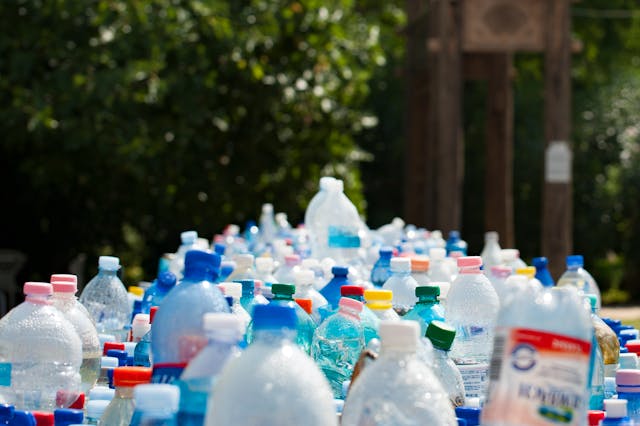
Is there anything that can eat plastic? There are some bacteria that can eat plastic and the larvae of the wax moth can also digest plastic. However, they cannot digest all plastics and they take a long time. There is nothing that can eat all plastics.
The main problem with plastic is the main reason why we use it. It is incredibly strong and durable. A plastic is made up of a lot of groups of molecules that bond with other groups of molecules. A single group of molecules is called a monomer. When they bond to other molecules, they are called polymers. These polymers are incredibly long and strong. It is very difficult to break them, but they are also flexible. That is why you can squash a drink bottle with your hands but you won’t be able to tear it. There are many types of plastic and they are all made from different molecules and are slightly different, but they all share the properties of being strong and durable. These properties are what make plastics invaluable for us, but also the ruin of the environment.
It was thought that nothing could eat plastic and that there was nothing to do but wait the thousand years or so for it to break down under UV light. However, recently scientists have discovered a bacteria that can break down one type of plastic. Plastic is a purely manmade product that does not exist in nature. It makes sense that there would be no bacteria that can digest it. However, that doesn’t take into account the sheer number of bacteria that exist and how fast they are able to evolve. There are bacteria that can live in the most difficult of environments and break down the most unlikely of substances for food. If it means they have a food source and no competition, chances are high that a bacteria would evolve to feed on plastic. After all, there is a lot of it about.
The bacteria that scientists have discovered is called Ideonella sakaiensis. It is able to digest the plastic called polyethylene terephthalate, more commonly known as PET. This is the plastic used to make drink bottles and we produce roughly 500 billion of them a year. Ideonella sakaiensis can break down the bonds between the molecules using an enzyme called PETase. Once it has broken the bonds, it can digest the monomers and use them for energy. The bacteria then secrete the monomers that they don’t use as waste. These bacteria were first discovered because of that waste. Researchers at a university in Japan were taking soil samples from an area that had been contaminated near a PET bottle recycling plant. The soil sample was full of the waste product from the bacteria, and that led the researchers to discover the bacteria itself.
This sounds like the miracle cure for the planet that we have been looking for, but it is not. At least, not yet. The bacteria can only break down PET if the temperature is over 30℃. They also break it down very slowly. In experiments, Ideonella sakaiensis were able to break down 0.2 mm of PET in about 6 weeks. That is not fast enough to solve the world’s plastic problem.
Scientists have managed to genetically analyze the PETase enzyme and modify it so that it breaks down the polymer bonds much faster. They have also modified it so that it works in colder temperatures. However, it is still not fast enough to manage with the enormous quantities of PET bottle we produce. It also doesn’t work on other plastics and the process of breaking it down produces CO2, which we can’t really afford. Still, it is a step in the right direction.
Scientists have also found that waxworms, the larvae of the wax moth can digest low-density PE. This is the kind of plastic you find in shopping bags. Waxworms use a different enzyme, but they break down plastic in the same way as the Ideonella sakaiensis bacteria. The enzyme they have is called phenol oxidase and it breaks the bonds in the polymers. Waxworms release this enzyme in their saliva and they have it because their main choice of food is the wav in bee nests. They are a pest and they can badly damage a hive. However, it turns out that the enzyme they have to break apart wax polymers will also work on plastic polymers, so the worms can happily eat one kind of plastic as well as wax. It would be impractical to breed trillions of these worms to take care of our plastic, but scientists are working on taking and modifying their saliva.
All of these things do show some hope, but we still need to cut down the amount of plastic we produce and use each year. No method in the world will be able to take care of the plastic if our usage keeps going up exponentially. And this is what I learned today.
Try these next:
Sources
https://en.wikipedia.org/wiki/Ideonella_sakaiensis
https://www.theguardian.com/environment/2023/sep/28/plastic-eating-bacteria-enzyme-recycling-waste
Photo by mali maeder: https://www.pexels.com/photo/assorted-plastic-bottles-802221/

Pingback: How many types of plastic are there?